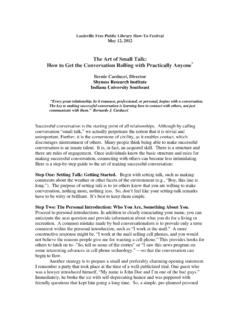Transcription of The Art of Small Talk: How to Get the Conversation Rolling ...
1 Louisville Free Public Library How-To Festival May 12, 2012. the art of Small Talk: How to Get the Conversation Rolling with practically Anyone*. Bernie Carducci, Director Shyness Research institute Indiana University Southeast Every great relationship, be it romance, professional, or personal, begins with a Conversation . The key to making successful Conversation is learning how to connect with others, not just communicate with them. Bernardo J. Carducci Successful Conversation is the starting point of all relationships. Although by calling Conversation Small talk, we actually perpetuate the notion that it is trivial and unimportant.
2 Further, it is the cornerstone of civility, as it enables contact, which discourages mistreatment of others. Many people think being able to make successful Conversation is an innate talent. It is, in fact, an acquired skill. There is a structure and there are rules of engagement. Once individuals know the basic structure and rules for making successful Conversation , connecting with others can become less intimidating. Here is a step-by-step guide to the art of making successful Conversation : Step One: Setting Talk: Getting Started. Begin with setting talk, such as making comments about the weather or other facets of the environment ( , Boy, this line is long.)
3 The purpose of setting talk is to let others know that you are willing to make Conversation , nothing more, nothing less. So, don't feel like your setting-talk remarks have to be witty or brilliant. It's best to keep them simple. Step Two: The Personal Introduction: Who You Are, Something About You. Proceed to personal introductions. In addition to clearly enunciating your name, you can anticipate the next question and provide information about what you do for a living or recreation. A common mistake made by bad conversationalists is to provide only a terse comment within the personal introduction, such as I work at the mall.
4 A more constructive response might be, I work at the mall selling cell phones, and you would not believe the reasons people give me for wanting a cell phone. This provides hooks for others to latch on to--"So, tell us some of the stories or I saw this news program on some interesting advances in cell phone technology. so that the Conversation can begin to flow. Another strategy is to prepare a Small and preferably charming opening statement. I remember a party that took place at the time of a well-publicized trial. One guest who was a lawyer introduced himself, My name is John Doe and I'm one of the bad guys.
5 Immediately, he broke the ice with self-deprecating humor and was peppered with friendly questions that kept him going a long time. So, a simple, pre-planned personal introduction can help jumpstart a Conversation . Step 3: Pretopical Selection: Fishing for Topics. Next, move to pretopical selection by throwing out topics for possible discussion. I really like this movie. The implicit rule is, when someone throws out a topic, support it either by asking a question or making a comment. Bad conversationalists often think they need to say something critical or brilliant; unable to do either, they say nothing at all.
6 Also, you shouldn't feel like a failure if people don't respond to the topic you've tossed out. It may take two or three attempts until you hit on a topic that triggers a response. Step Four: Posttopical Elaboration: Expanding the Topic. Now, advance to post- topical elaboration by associating the topic of Conversation to other related topics. For example when talking about the vacations, you might say, Speaking of vacations, we had some great Caribbean food on our last vacation. Now you can talk about food or food-related topics ( , other ethnic foods, cooking shows, music heard in restaurants).
7 It's the give-and-take of post-topical elaboration that makes conversing so much fun. Step Five: Conversation Termination: A Gracious Ending that Creates the Connection. Finally, when terminating a Conversation , let the person know you'll be leaving soon, express gratitude for the Conversation , summarize some of the major points, and set the stage for future Conversation . For example, you can say, I really must be going soon, but I had a great time chatting with you. I really appreciate your comments about that new movie. Here's my card. Call me if you know of any other movies you think I might enjoy.
8 Here are two more pieces of advice to remember: Bad conversationalists also tend to get stuck at setting talk. Or they spend too much time focused on their favorite topic, whether it's baseball statistics or Star Wars. They think they are being social because they are talking. But they dominate the Conversation , talking at somebody, not with someone. So remember, the key to being a being a successful schmoozer is simple: you don't have to be brilliant but you do have to be kind--show a willingness to converse and support the efforts by others who do the same. *Based on Bernardo J. Carducci's The Pocket Guide to Making Successful Small Talk: How to Talk to Anyone Anytime Anywhere About Anything (1999, Pocket Guide Publishing).
9 For more information on The Pocket Guide, go to: and click on Links.. Louisville Free Public Library How-To Festival May 12, 2012. the art of Small Talk: How to Get the Conversation Rolling with practically Anyone*. Bernie Carducci, Director Shyness Research institute Indiana University Southeast *Based on Bernardo J. Carducci's The Pocket Guide to Making Successful Small Talk: How to Talk to Anyone Anytime Anywhere About Anything (1999, Pocket Guide Publishing). For more information on The Pocket Guide, go to: and click on Links.. the art of Small Talk: How to Get the Conversation Rolling with practically Anyone Basic Philosophy Every great relationship, be it romance, professional, or personal, begins with a Conversation .
10 The key to making successful Conversation is learning how to connect with others, not just communicate with them.. Bernardo J. Carducci Some Basic Issues Basic Myth: You Are Not Born with the Gift of Gab . Basic Purpose: Letting Others Know You Are Willing to Talk Basic Principle: You Don't Have to Be Brilliant; You Just Have to Be Nice Basic Guideline: Make It Easier for Others It's About Them, Not About You Basic Mistake: Alcohol Consumption as a Substitute for Confidence The Formula for Making Successful Small Talk: A Step-by-Step Approach Basic Objective: Finding Common Ground Basic Rule: Make It Easier for Others It's About Them, Not You Basic Format for Making Successful Small Talk: Knowing and Following the Steps for Engaging Others Step 1: SETTING TALK: GETTING STARTED.










